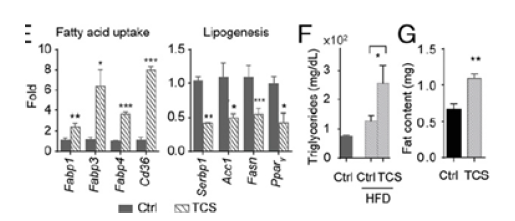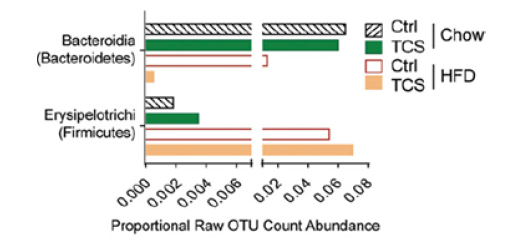Superfund Research Program
Triclosan and a High-fat Diet Worsen Liver Disease in Mice
View Research Brief as PDF(512KB)
Release Date: 02/03/2021
![]() subscribe/listen via iTunes, download(6.8MB), Transcript(111KB)
subscribe/listen via iTunes, download(6.8MB), Transcript(111KB)
A new study funded by the NIEHS Superfund Research Program (SRP) shows triclosan exposure, in combination with a high-fat diet, can worsen nonalcoholic fatty liver disease. Led by Robert Tukey, Ph.D., researchers at the University of California San Diego SRP Center described the molecular mechanisms by which triclosan alters metabolism and gut microbiota, resulting in fat buildup in the liver.
Triclosan is an antibacterial chemical used in many consumer products including soaps, toothpaste, cosmetics, and plastics. Triclosan from household products has been detected in treated wastewater, raising additional concerns for human and environmental health. Triclosan can contaminate drinking water supplies and enter the food chain. Tukey and team previously observed that exposure to triclosan increases susceptibility to fibrosis and liver tumor formation in mice.
Identifying changes in the liver
The researchers fed mice a high-fat diet for 18 weeks. Some of the mice were also fed triclosan, resulting in blood concentrations comparable to those observed in human studies.
The team observed that mice treated with triclosan exhibited elevated levels of oxidative stress, hepatic fibrosis, and inflammatory responses. Like a high-fat diet, triclosan could be a major contributor to the development of fatty liver disease, according to the authors.

When mice were cotreated with triclosan together with a diet high in fact, triclosan altered the expression of genes associated with fatty acid uptake and lipogenesis. Triclosan also elevated triglyceride levels in serum and increased fat build-up in the liver. (Image courtesy of Yue et al. 2020)
Triclosan alters metabolism
The fibroblast growth factor 21 (FGF21) is a protein that regulates metabolic functions of the liver and protects liver cells from damage. Eating a high-fat diet normally activates FGF21 as a protective feedback response
In mice exposed to triclosan and a high-fat diet, expression of FGF21 was lower compared to mice receiving only a high-fat diet. Triclosan exposed mice also showed an imbalance in amino acid metabolism, high levels of lipids in the blood, and insulin resistance exacerbating the effects of a high-fat diet.
Triclosan-exposed mice with lowered FGF21 also showed disrupted expression of genes involved in amino acid metabolism. This discovery was linked to metabolic imbalance, high cholesterol, and insulin resistance in mice eating a high-fat diet.
The researchers further revealed the mechanism involved in FGF21 changes, in which triclosan modifies the expression of the transcription-activating factor 4 (ATF4) and the peroxisome proliferator-activated receptor α (PPARα). By inhibiting these pathways, they observed a drastic decrease in triclosan-induced FGF21 dysregulation. According to the authors, these findings suggest that ATF4 and PPARα are critical regulatory networks that ultimately contribute to the development of liver disease.
Triclosan alters the microbiome
Alterations in the normal composition and diversity of bacteria in the gut are associated with various diseases, including nonalcoholic fatty liver disease. Given triclosan's antimicrobial capabilities, the researchers analyzed fecal samples to assess how triclosan affected gut microbiota.
The team found that triclosan, along with a high-fat diet, diminished bacterial diversity and induced intestinal microbiota imbalance.
According to the authors, changes in microbiota composition in mice exposed to triclosan were similar to those observed in humans with metabolic disorders or inflammatory disease. For example, they observed a reduced proportion of Bacteroidetes and increased Firmicutes microbiota, a common occurrence linked to liver disease, inflammation, and insulin resistance.
The researchers suggest triclosan may contribute to metabolic disorders by compromising the microbial intestinal barrier and releasing toxins to the bloodstream. Metabolic disorders are associated with increased risk of developing a variety of chronic diseases, and further research is needed to delineate the mechanisms linking intestinal microbiota imbalance to changes in metabolism.

The researchers observed that a high-fat diet decreased fecal Bacteroidetes and increased Firmicutes, and these changes were exacerbated when mice were fed a high-fat diet containing triclosan. (Image courtesy of Yue et al. 2020).
Research implications
The scientists stressed that exposure to triclosan in conjunction with a diet high in fat is common, resulting in potential concern for human health. In future work, the researchers suggest using experimental models with mice lacking FGF21 to confirm the direct link of its involvement in metabolic changes induced by triclosan.
This work illustrated the underlying mechanisms by which triclosan exacerbates high-fat, diet-induced liver disease. This improved mechanistic insight provides a basis for developing therapeutic approaches to treat and prevent toxicant-associated nonalcoholic fatty liver disease.
For More Information Contact:
Robert H. Tukey
University of California-San Diego
Department of Pharmacology
9500 Gilman Drive, MC 0722
La Jolla, California 92093-0722
Phone: 858-822-0288
Email: rtukey@health.ucsd.edu
To learn more about this research, please refer to the following sources:
- Yueh MF, He F, Chen C, Vu C, Tripathi A, Knight R, Karin M, Chen S, Tukey RH. 2020. Triclosan leads to dysregulation of the metabolic regulator FGF21 exacerbating high fat diet-induced nonalcoholic fatty liver disease. Proc Natl Acad Sci U S A 117:31259-31266. doi:10.1073/pnas.2017129117 PMID:33229553 PMCID:PMC7733785
To receive monthly mailings of the Research Briefs, send your email address to srpinfo@niehs.nih.gov.


